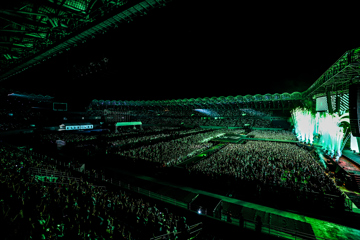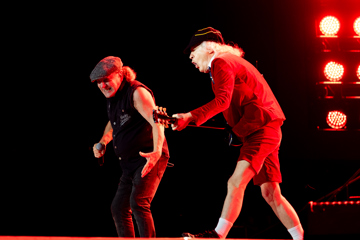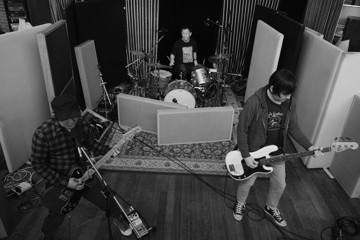Why You Should See 'Good Time' Despite It 'Spiralling Out Of Control'
The latest reviews from Film Carew.
GOOD TIME

The Safdie Bros’ kinetic crime-thriller Good Time sets Robert Pattinson in a downward spiral of terrible choices, things turning from bad to worse across 100 restless minutes. It’s one of those movies that take place largely across one night, in a nocturnal underworld in which anything feels possible, but failure is probable.
Pattinson — forever twitchy, all bleached hair and goatee, Queens accent laid on thick — plays a small-time hustler who is, for the moment, on the outside. His partner-in-crime, literally, is his brother, played by (an also barely-recognisable) co-director Benny Safdie. Hearing impaired and developmentally disabled, he’s the younger sibling by both age and standing, the beta-male in their blustering brother act. Social services view their relationship through a simple binary — Pattinson is the bad influence, Safdie the victim — but their relationship of mutual dependence doesn’t just flow one way. They’re a pair, united in 'us-against-the-world' solidarity.
Don't miss a beat with our FREE daily newsletter
We meet this younger brother in an interview with a councillor, who’s testing him for his cognitive abilities, with regards to language and idiomatic turns of phrase. The scene is shot through with vérité, documentary-like; an uneasiness persisting. It also shows us the viewpoint of Safdie’s character: how those who’re out to help him are to be doubted, but the brother out to ‘hurt’ him is loved doubtlessly. Case and care workers have endless questions; Pattinson has answers.
Older bro bursts in with a shock, and is, thereafter, a livewire; Pattinson’s performance electric, as if matching the electronic pulse of Oneohtrix Point Never’s synthy score, which openly evokes Tangerine Dream’s OST for Michael Mann’s spiritual-predecessor, Thief. Nothing about Josh and Benny Safdie’s previous films — the shaggy-dog mumblecore lark The Pleasure Of Being Robbed, the kids-behaving-badly comedy Go Get Some Rosemary, the basketball-biz docu-tragedy Lenny Cooke, the screeching junkie malarkey Heaven Knows What — would’ve suggested cinematic comparisons with Mann, or even with hard-bitten genre-pictures, but Good Time marks an evolutionary leap for the filmmakers.
The film looks as electric as it feels: the Safdies, working with the regular cinematographer Sean Price Williams, paint a lurid portrait in the surreal colours of cities: everything turned alien shades by tungsten and fluorescent light, the collisions between illumination and darkness feeling harsh, forbidding. The movie moves with a constant sense of motion, the editing — by Benny Safdie and Ronald Bronstein — keeping the action throttling along. At first, this sense of momentum is delivered by its protagonist, whose impulsiveness and naked desire serve as narrative engine. Pattison is less an agent of action, more of chaos, and soon the film feels like the life of its anti-hero: spiralling out of control, a runaway train heading for a horrific crash.
Pattinson pulls his brother out of therapeutic appointments, and ropes him into a bank job. The heist goes off without a hitch, until it doesn’t: their bag of cash containing a dye pack, which sprays paint throughout the getaway car, all over their clothes, in their eyes. There’s a crash, a foot chase, and, for Pattinson, an escape. Safdie, though, is caught; and, swiftly, he ends up in Rikers Island, then in a hospital bed, the victim of a beatdown.
Pattinson, riddled with guilt and blessed with a bounty of bad ideas, endeavours to get his brother out: first begging his girlfriend (Jennifer Jason Leigh) to put up the bail money, then setting out to break his brother out of his hospital bed. That, too, is a heist that, seemingly, goes off without a hitch: Pattinson deludes the security, distracts the cops, finds a criminal figure whose head is wrapped entirely in bandages, and manages to get out of the hospital, pushing the escapee in a wheelchair onto a city bus. Only, underneath the bandages, the man he’s emancipated isn’t actually his brother.
It turns out to be Buddy Duress, the actor whom the Safdies discovered for Heaven Knows What, and a former real-life Rikers Island inmate. Duress plays a criminal who matches Pattinson for anxious energy and poor decision-making skills, the pair egging each other on as the night involves more ridiculous plans, wild-goose chases, close shaves, momentary moments of eluding the law. There’s drugs, sex, vice, delusion. Pattinson doesn’t give a dog a handjob (as was earlier reported about the film) but there’s the sense he could; that he could do anything, and that the film would follow.
With Good Time, the Safdie Bros were out to make “a piece of pulp that actually felt dangerous”, and Pattinson’s character is the avatar of that danger. He’s dangerous to anyone he crosses paths with — he’ll lie, cheat, steal, harm — but, mostly, he’s a danger to himself.
In turn, the film floats little hope that its central criminal will ‘get away with it’. This theme is made visual in an astonishing overhead shot, near close, that shows how small he is, how futile his struggle: Pattinson seeming like a rat in a maze, the Queens grid a veritable prison. In Good Time, he bounces around these mean streets, full of desperation and wild ideas, but there’s no chance he’ll escape.
THE ONLY LIVING BOY IN NEW YORK

Oh, God, it’s one of those movies where a character within writes a book, and the book has the same name as the film, and turns out to be the story of the film. Where the opening narration — by, seemingly, an omniscient narrator— turns out to have been spoken by Jeff Bridges’ drunken, aging, reclusive writer, and by the end of the film, he’s reading the exact same narration at a book reading, as the opening pages of the new novel he wrote herein, inspired by the events of the story of the film.
If this feels like a faux-clever and unnecessarily-convoluted framing device, The Only Living Boy In New York goes further with the belaboured attempts at cod-profundity and layered meaning. Evoking the literary mythos of New York City is one thing, but as Bridges delivers sage wisdom and writerly insight — in a script, by Allan Loeb, which is way too pleased with itself — you find yourself yearning for the caustic, dickish depiction of macho authors in Alex Ross Perry’s obnoxious Listen Up Philip; or for this antiseptic vision of New York to suddenly descend into Good Time’s nocturnal hell.
Loeb has no desire in penning anything remotely provocative, though. And director Marc Webb, swiftly following up his recent kids-say-the-darnedest-things custody-drama Gifted, remains a desperate crowdpleaser. Together, they deliver a film that thinks that peddling clichés is okay if you knowingly acknowledging them. So, Bridges, in his opening narration, talks of how kids-these-days think romance is found in the rain — “like in the movies” — and, then, sure enough, movie-rain is employed by the film itself, at all the most predictable, tedious times.
The title of The Only Living Boy In New York sure comes from the Simon & Garfunkel song (big year for S&G songs as film titles, following Baby Driver), which means you can set your watch by when it’ll play: at the end of the second act, when its boy, duly named Tom (Callum Turner), is left standing in the rain(!), and the things-are-going-sad montage plays. Even worse, Kate Beckinsale plays a character named Johanna, Bridges makes several references to Visions Of Johanna, and, then lo, fire up the Dylan, this time in a scene where Turner is running through the streets. And, yes, let’s lament another film firing up expensive-song-placement Baby Boomer Greatest Hits (hey, it’s A Whiter Shade Of Pale again!), and all the unquestioning nostalgia that goes with.
The hook for this film is that Turner, a bookish kid with writerly dreams, finds out his dad (Pierce Brosnan) has a mistress (Beckinsale), and then ends up having sex with that mistress. Loeb is out to author The Graduate 2: Electric Boogaloo, but what he delivers feels like the storyline from a porno. The film is, in such, pure male fantasy fulfilment, operating as an uncritical portrait of male entitlement.
Turner is a ‘nice guy’ stuck in the ‘friendzone’ with Kiersey Clemons — she appears to be his only friend — which enrages this child of Manhattanite privilege; Turner railing, often, about how he should be with her, that the fact she hasn’t fucked him yet a miscarriage of justice. Clemons has some boyfriend we never see that she’ll invariably break up with, and little agency or desires of her own; she exists solely as love-interest, her only narrative function as object of pursuit, the only question whether or not she’ll give it up. The bespectacled boy out to bed the hot girl is a cliché just as haggard as finding-romance-in-the-rain, yet The Only Living Boy In New York never calls it into question. Ultimately, this suggests the whole: this is a fine example of a film that thinks it’s all too clever, yet, dramatically, is deeply stupid.
TOM OF FINLAND

Tom Of Finland suffers a simple problem that perennially afflicts spanning-decades biopics, be they cut-rate telemovie or Clint Eastwood’s J. Edgar. It stars Pekka Strang as its titular subject, the Finnish artist whose luridly-homoerotic drawings verily gave birth to the Leather-Daddy subculture. Strang is a 40-year-old actor, which means that when he’s playing Tom as a 20-year-old soldier, he’s way too old; looking nothing like some strapping youth thrilled by the sexual tension of the troop, more a middle-aged banker wandered into a field. Yet, playing Tom as a 60-something gay-movement icon, Strang is plastered in unconvincing mock-aging make-up, all latex wrinkles and daubed-on liver-spots.
Strang is on screen, throughout, because director Dome Karukoski has made a portrait of a queer iconoclast which is shot through with cinematic convention. Tom Of Finland has already been submitted as Finland’s official submission for the Best Foreign Language Film at next year’s Academy Awards, and the film plays like predictable, unambitious Oscar-bait.
Here, yet another biopic life is set against the 20th century, as our man Tom faces WWII, the Gestapo, cops, moralisers, prejudice, censorship and AIDS. When he walks through a park at night, the threat of danger looms; when his “sissy” boyfriend (Lauri Tilkanen) coughs, you can tell he’s going to die soon; and when there are literally shots of ice melting, the social-change symbolism is on the nose.
Though its subject — taciturn, macho, constantly smoking, haunted by wartime flashbacks, kind of a prick — just wants the world to leave him alone so he can draw endless pictures of men with oversized muscles and ridiculous erections, Tom Of Finland, itself, won’t leave him alone. In Aleksi Bardy’s patently ‘inspirational’ screenplay, he’s conceived as an artistic iconoclast and author of cultural change, his across-the-decades life duly shoehorned into a message-movie template.
BIG TIME

Bjarke Ingels is the architecture world’s equivalent of a Silicon Valley star: a cultishly-beloved, oft-criticised figure whose grand designs forward pleasing notions of progressiveness, outside-the-box thinking, and even that most idealist of ideals: making the world a better place. He’s the subject of Kaspar Astrup Schröder’s documentary Big Time, whose name alludes to BIG, Ingels’ architectural firm. It’s less hagiography, more workplace documentary, with the subject shown at work, in meetings, pitching ideas, dealing with clients. In a recurring device, Ingels sits down at a ream of butcher-paper with a fat black marker, and sketches for the camera, talking through geographic spaces, buildings, architectural psychology, his own plans.
Invariably, the central subject serves as something of a narrative hero: a man out to challenge convention, promote sustainability, improve cities; someone who wants real estate developments to be positive social developments. Big Time begins with him back in Copenhagen, at his parents house; and, there, he tells an anecdote that amounts to an origin story, about a childhood annoyance at not being allowed to be up on the roof; the top of his family home so much wasted space.
Our hero has a genuine obstacle to overcome, too. In a dramatic development that tilts Big Time from polite documentary profile into something more artistic — and more loaded — Ingels suffers a concussion, experiences recurring headaches, then has an MRI of his brain, which show a small cyst. This inspires Schröder to stage artful, stylised sequences where brain scans cavort in balletic laser-show, and for Ingels to grow contemplative, thoughts turning to mortality.
A memorable movement has him talking through architecture history over black-and-white images of iconic buildings, noting all those visionaries — Le Corbusier, Gaudí, Khan, Scarpa, Saarinen — who died in odd circumstances whilst still working. Later, Ingels is shown jogging in slow-motion over the Brooklyn Bridge, whilst computer images of the designs for all his future projects are shown in montage; evoking those notions of mortality and immortality, of the work persisting beyond the days of its creator. These are moments of lyricism that bring Big Time to life, at the same time as Ingels contemplates his own life.
BLUE

The title of Karina Holden’s documentary, Blue, refers to its subject, with due simplicity and reverence: the ocean. But it also evokes how the local filmmaker has approached making her disquieting portrait of a planetary ecosystem being turned slowly toxic: with vivid imagery and bright colours. Where most docs chronicling the world’s ills lean on talking-heads and powerpoint-ish info graphics, Holden, instead, authors a work of visual splendour: from eye-of-God overheads to shots deep under the waves, she marshals a host of high-res images, making broadly accessible a work of filmmaking eco-activism.
This photography shows the glories of oceanic opulence in screen-saver-worthy wonder, but also the horrors afflicting it in excruciating detail: the slurry of plastic gathering in swept-up pools at the edge of ocean gyres, the schools of fish being shepherded into the nets of factory-fishing trawlers, the graveyards of bleached coral that stand as Australia’s great ecological shame. These images carry as much horror as the facts: that half of all marine life has been lost over the past 30 years; that in two decades’ time there’ll be more plastic than fish in the ocean; that particles from polyester and nylon clothing have been found in plankton, the food-chain infected with plastic from the very bottom.
Blue finds Holden touring various spots of interconnected oceanic trauma, the Pacific the film’s great landscape. There’s the shark markets of Lombok and tuna markets of the Philippines, where desperate locals peddled species being fished to extinction. A Cape York wildlife ranger cleans up the “ghost nets” that drift across seas, trapping marine-life as they go; whilst Hawaiian surfers catch waves filled with rubbish. A Canadian scientist on Lord Howe Island (who was previously seen in A Plastic Ocean) removes belliesful of ingested plastic from Shearwaters, birds so bloated with bottle-caps and shards of PVC that they need their stomachs pumped. And, finally, ultimately, the trip ends at the Great Barrier Reef, where the tragedy of coral bleaching stands as sure bellwether for oceanic health, a warning sign of a looming ecological cataclysm.







